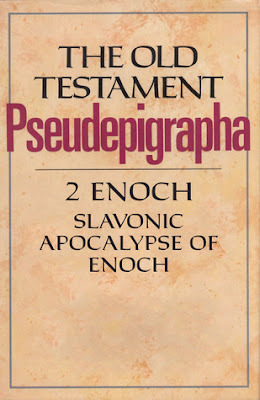Slavonic Apocalypse

The term "Slavonic Apocalypse" often refers to 2 Enoch, also known as the Slavonic Book of Enoch or the Secrets of Enoch. It is an ancient Jewish pseudepigraphal text preserved in the Slavonic language.
The Slavonic Apocalypse (2 Enoch) primarily describes:
Enoch's celestial ascent: The core of the text revolves around the patriarch Enoch, the seventh generation after Adam, being taken by angels to journey through the seven heavens.
His initiation into heavenly mysteries: Enoch gains access to divine secrets and knowledge about creation and the universe during his heavenly ascent.
His luminous metamorphosis: Enoch undergoes a transformation near the Throne of Glory, becoming a celestial being. This transformation is linked to themes of the "ointment of glory," a luminous substance that signifies his new, heavenly nature.
Themes of redemption and the "ointment of glory": The text explores the idea that Enoch, through his righteousness and ascent, is able to "carry away the sin of humankind," according to Marquette University specifically addressing the primeval sin of Adam. The "ointment of glory" he receives in heaven plays a significant role in this transformative and redemptive process.
The structure and cosmology of heaven: The text presents a detailed cosmology of the seven heavens, describing their inhabitants and Enoch's experiences in each one.
Adamic and Melchizedek traditions: The book incorporates traditions related to Adam, portraying him as a microcosm and exploring the origins of his name. It also includes a unique account of the birth and role of Melchizedek.
Jewish apocalypticism and mysticism: The Slavonic Apocalypse draws upon Jewish apocalyptic traditions but also incorporates new mystical elements, serving as a bridge between early apocalyptic writings and later Jewish mystical traditions like Merkabah mysticism.
In essence, the Slavonic Apocalypse (2 Enoch) is a fascinating exploration of Jewish mystical and cosmological ideas, focusing on the transformative journey of Enoch and his role as a redeemer figure.
The term "slavish language" is not a recognized term in linguistics. It seems to be a combination of the word "slavish" which means servile, and "language." The Slavic languages are a diverse group of Indo-European languages spoken by millions of people across Europe and Asia, and it is possible the user is interested in this language family.
Here's a more helpful explanation of what the user might be looking for:
Slavic Languages:
The Slavic languages are a branch of the Indo-European language family. They are spoken by a large number of people in Eastern Europe, the Balkans, parts of Central Europe, and northern Asia.
Key Features of Slavic Languages:
Proximity:
Slavic languages are closely related to each other, sharing common roots in Proto-Slavic.
Diversity:
The Slavic languages have diverse forms, with three main subgroups: East Slavic, West Slavic, and South Slavic.
Geographic Distribution:
Slavic languages are spoken across a vast geographical area, including countries like Russia, Ukraine, Belarus, Poland, Czech Republic, Slovakia, and many Balkan nations.
Examples of Slavic Languages:
East Slavic: Russian, Ukrainian, Belarusian.
West Slavic: Polish, Czech, Slovak.
South Slavic: Bulgarian, Serbian, Croatian, Macedonian, Slovenian, Bosnian.
In summary: The user is likely asking about the Slavic languages, a family of related languages spoken by millions of people across Europe and Asia, rather than a "slavish language" which is not a recognized term.
Slavish Language:
The term "slavish language" is not a recognized term in linguistics. It seems to be a combination of the word "slavish" which means servile, and "language." The Slavic languages are a diverse group of Indo-European languages spoken by millions of people across Europe and Asia, and it is possible the user is interested in this language family.
Here's a more helpful explanation of what the user might be looking for:
Slavic Languages:
The Slavic languages are a branch of the Indo-European language family. They are spoken by a large number of people in Eastern Europe, the Balkans, parts of Central Europe, and northern Asia.
Key Features of Slavic Languages:
Proximity:
Slavic languages are closely related to each other, sharing common roots in Proto-Slavic.
Diversity:
The Slavic languages have diverse forms, with three main subgroups: East Slavic, West Slavic, and South Slavic.
Geographic Distribution:
Slavic languages are spoken across a vast geographical area, including countries like Russia, Ukraine, Belarus, Poland, Czech Republic, Slovakia, and many Balkan nations.
Examples of Slavic Languages:
East Slavic: Russian, Ukrainian, Belarusian.
West Slavic: Polish, Czech, Slovak.
South Slavic: Bulgarian, Serbian, Croatian, Macedonian, Slovenian, Bosnian.
In summary: The user is likely asking about the Slavic languages, a family of related languages spoken by millions of people across Europe and Asia, rather than a "slavish language" which is not a recognized term.
https://crosssides.blogspot.com/


